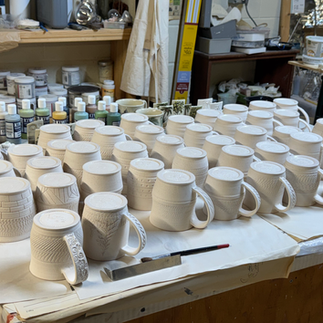July Mug of the Month Progress Update: Frank Parker
- PennOhio Clay Guild

- Jul 25
- 3 min read
Updated: Aug 9

"On the path toward creating the limited edition mugs for July it seemed like a fairly straightforward design and production process."
But as any potter knows, the path from idea to finished piece often winds through unexpected turns—and along the way, this experience offered more than a few valuable lessons. I can honestly say that I’ve grown as a potter, both in technical skill and in my evolving vision for future work.
Outside of the studio, I also enjoy painting with watercolors, and I’ve found some delightful parallels between clay and watercolor. In both, there’s a dance between control and letting go—between skill and serendipity. Whether it’s pigment on paper or glaze on clay, the materials often have a mind of their own. There’s beauty in that unpredictability. And sometimes, there’s failure. But other times, the results surprise you in the best way.
I’ve long wanted to blend my watercolor background with pottery—specifically, using underglazes to layer and blend colors in ways that bring natural subjects to life. After an early attempt ended in disappointment (my preferred way to learn, apparently), I decided to commit to using underglazes on these mugs. Alongside color, I’ve also been working to add texture—through slip-trailing, carving, and even some unexpected experimentation. (Oversized coconuts turned out to make a much better motif than simple slip dots!)
One surface technique I’m really enjoying is chattering, where a flexible tool bounces across spinning clay to create rhythmic patterns. I usually chatter the bottoms of my mugs, but for this series, I also added the technique to the base of the mug wall to evoke a sense of ground or sand. It’s a satisfying process, even if it does fling little bits of clay all over the studio. Like everything else in clay, a successful textured outcome depends on many variables: wheel speed, clay moisture, tool pressure, and more.
The mugs begin with 1½ pounds of white stoneware clay. I form the basic shape, then allow the piece to slowly release from the bat. Once leather-hard, I trim—removing excess clay from the base—then chatter both the bottom and base wall. Slip-trailing is next, building up the tree trunks and branches, followed by carving in the leaves and finer details.
For the handles, I start with a tapered coil, flatten it, and run a textured roller over the surface. Then I shape and curve it to fit the mug. After resting for an hour, I attach the handle with slip and score, reinforcing the connection with a small coil. I cover the mugs for two days to allow moisture levels to even out between the mug and handle.
After several more days of drying, the mugs were ready for the bisque kiln.
Included in this progress update are some images of my early test tiles using underglazes to color the sliptrailed design on the bisqueware prior to a final coat of a clear, glossy glaze which is applied before final glaze firing in the kiln at cone 6.
As always, I’ll keep you posted as things progress. Thanks for coming along on this journey!
~Frank
Reservations to purchase his limited edition mug are available now. The final presentation of the mugs typically occurs by the end of the month.
Please note, due to the nature of Frank's designs, mug choice will be offerred in the order of reservation date.









































Comments